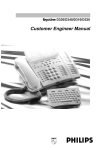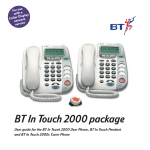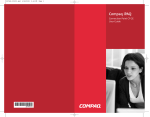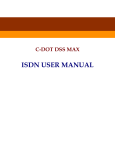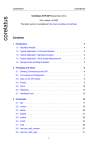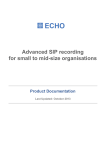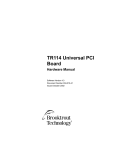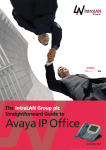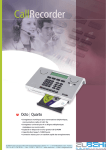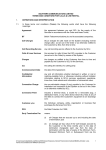Download Connecting to ISDN 30
Transcript
Your guide to ISDN 30 Contents Installing an ISDN line – the beginning Connecting to ISDN 30 Delivery Options Customer Interface Connection of CPE & Digital Select Services Description of Digital Select Services ISDN Applications Fault Reporting Now You’re Connected Always in Touch Cost-effective Communications Useful Numbers 1 2 3 7 8 10 16 18 19 21 23 25 For further help and advice on any ISDN applications and how to connect them, call our helpline on Freefone 0800 18 15 14 or visit www.bt.com/isdn/isdn30/ This guide should take only about 15 minutes to read. Please do so because it should save you a good deal of time in the long run and help you make the most of your ISDN 30 right from the start Installing an ISDN line is just the beginning Many people buy ISDN 30 just for its For instance, because ISDN is digital, voice capabilities. And although these it can carry so much more information are second to none, we’d like to show than a normal analogue telephone line. you how to get more from the service. You can use it to send and fax That’s why we’ve devised this simple documents, access the Internet or step-by-step guide. You’ll discover all link up with other computers – the different ways you can use your with amazing clarity and speed. system – many of which you may never have considered before. What’s more, ISDN 30 helps you spread your communications load. With up to thirty independent 64kbit/s channels for voice or data per cable, you can use ISDN to perform different tasks simultaneously. Even better, because ISDN 30 is an integral part of the main telephone network, you can use it to communicate with people who have normal analogue telephone lines. So start using your ISDN 30 line today. There’s no end to what it can do for your business. 1 Connecting to ISDN 30 ISDN 30 Description ISDN 30 is the trade name for BT’s primary rate service for the delivery of digital exchange lines. ISDN 30 is a 2Mbit/s digital connection from the BT telephone exchange to the Customer’s Premises Equipment (CPE). Each 2Mbit/s system provides: Up to 30 independent 64kbit/s channels (for voice or data) 1 x 64kbit/s channel for synchronisation and maintenance and 1 x 64kbit/s channel used for signalling. 2 There are two versions of ISDN 30 available: ISDN 30 (DASS2) This service uses the BT signalling system DASS2. ISDN 30e The signalling used on this service is Q.931 (ETSI version) which conforms to the worldwide ITU-T (was CCITT) standard. Diagram 1 Alternative Routing iSPBX BT Network ISDN 30 ISDN 30 Local Exchange Delivery Options Alternative Routing Diverse Routing With this option, ISDN 30 services are routed via separate cables from the local servicing exchange. Where possible, the cables may be installed in separate ducts. With Diverse Routing, ISDN 30 access will be provided from the user’s local exchange and the nearest appropriate alternative exchange. Additional one-off charges will be raised if any extra duct or fibre is required. Additional one-off charges will be raised for any extra duct or fibre used. See Diagram 1 (previous page). Two different numbers will be provided for both access types. Diagram 2 Diverse Routing iSPBX BT Network ISDN 30 ISDN 30 Local Exchange Secondary Exchange See Diagram 2. 3 Delivery Options (cont) DDI Dual Parenting Dual Parenting enables ISDN 30 DDI* to continue operating in the event of a customer’s local exchange processor failing. This is achieved by connecting the customer to two separate local exchange processors, but keeping the same DDI telephone number range. Whilst both local exchange processors are working normally, alternate incoming calls are sent to them by the DMSU (Digital Main Switching Unit, part of BT’s core switching network) to which they are both connected. If there is a failure of either local exchange processor, all incoming calls are sent to the remaining exchange processor. * Direct Dialling In [DDI] (see page 15) 4 The following diagram illustrates this: DMSU Exchange Site Customer Site 50% of calls Normal Exchange Processor Incoming ISDN 30 DDI calls 100% of calls 50% of calls Alternative Exchange Processor Optional diverse route ISDN 30 Site Assurance Options 1&2 ISDN 30 Site Assurance options enable customers to have their ISDN 30 (DASS2) or ISDN 30e exchange calls re-routed to an alternative site, in a contracted time, if their normal site becomes unusable for any reason. Customers will call their Customer Management Service Centre and will be required to give a security code, which will be verified by BT before the changeover is carried out. The service is available in two options: Option 1 This option is delivered using the existing ISDN 30 (DASS2) basic diversion services or ISDN 30e basic forwarding services. This enables all incoming calls to a customer’s site to be diverted to a pre-arranged single number. This could be either another of the customer’s sites which is to be used as a standby, or a third party provider standby site. Basic diversion operates for voice calls only on ISDN 30 (DASS2) and basic forwarding for voice and data on ISDN 30e, assuming the standby site has an ISDN 30 service to receive such data calls. The customer will be charged for the diverted part of all the calls when the diversion is activated. On a customer request the Service Centre will arrange for changeover of service to the standby site within one hour. 5 Delivery Options (cont) 6 ISDN 30 Site Assurance Option 2 Network Termination This option is delivered by providing a group of ISDN 30 channels to a customer’s standby site, which are configured as Incoming Calls Barred (ICB). New ISDN 30 circuits will have to be ordered at standard ISDN 30 connection and rental costs, where the standby site is off the same serving exchange as the customer site. If the customer site is outside of the local exchange area, then Out of Area charges will apply. The ISDN 30 service terminates on your premises on Network Terminating Equipment (NTE). The type of NTE varies according to whether the ISDN 30 is served over copper cables (transverse screened) or optical fibre cable. The NTE can be either installed in a wall/desk unit which can house 2 NTEs or a rack mounted unit which can house up to 4 NTEs. Customer Interface ISDN 30 (DASS2) ISDN 30e Standby Power Regardless of the type of NTE fitted on your premises, a standard interface will be presented for connection to your CPE. The electrical interface conforms to CCITT recommendations G703 (75 Ohm unbalanced termination). This is presented by two coaxial cables each terminated with a BNC plug, conforming to BSI BS9210-N0001 part 2. For the ISDN 30e service, the interface connector is an I.421 socket EN 28877 (RJ45) 120 Ohm balanced and subsequently an ISO 101173 (subject to ratification) connector to the CCITT I.421 standard. If required, standby batteries can be supplied at a charge, giving up to five hours backup supply. Alternatively, power can be supplied from CPE equipment if it has standby power. These coaxial leads are connected to the NTE at the traffic in (TFC in) and traffic out (TFC out). Power Supply The 2Mbit/s NTE fitted when copper cable is used does not require a power supply as power is line fed from the BT exchange over the copper cable. This will give protection in the case of a power failure so that calls can be made, but only if the iSPBX has standby power as well. If no standby power is fitted and the power is switched off to the NTE, service will automatically be restored when the The 2Mbit/s NTE fitted when fibre optic power comes back on. cable is used does require a power supply. 7 Connection of CPE & Digital Select Services The CPE must be approved for connection to the network. This should be checked with your supplier. Digital Select Services DASS2 ISDN 30e Calling Line Identity Presentation (CLIP) Yes Yes Presentation Number Yes Yes Calling Line Identity Restriction (CLIR) Yes Yes ISDN 30e Connected Line Identity Presentation (COLP) No Yes The CPE can be disconnected from the network without activating urgent alarms. Connected Line Identity Restriction (COLR) Yes Yes Administration provided Basic Diversion – Voice Only Yes No Administration provided Diversion on Busy or failure of BT bearer – Voice Only Yes No ISDN 30 (DASS2) Administration provided Diversion on Ringtone No Reply – Voice Only Yes No Administration set up Call Forwarding – for all calls – Voice & Data No Yes Once the CPE is connected, it is advisable not to disconnect as automatic alarms will Reconnecting the CPE will restart the be activated in the local telephone service, but if five breaks occur in one exchange reporting a break in service. hour, the service will need reactivating in 8 the exchange. This can be done by calling Freefone 0800 800 154 and explaining the situation. Digital Select Services DASS2 ISDN 30e Administration set up Call Forwarding – on Busy – Voice & Data No Yes Administration set up Call Forwarding – on No Reply – Voice & Data No Administration provided permanent Outgoing Call Barring (OCB) Yes Customer Controlled Services* Diversions - not available across DDI (Basic, Busy/Failure, Ringtone No Reply) Yes Channel Busying Yes Call Barring Yes Customer Controlled Call Forwarding No Administration provided Selective Outgoing Call Barring All calls; International calls and Premium Rate Services (PRS); National, International calls & PRS; Operator calls; International, Operator calls & PRS Yes Yes Yes No No No Yes Yes Administration provide permanent Incoming Call Barring (ICB) Yes Call Charge Indication (CCI) Yes No Yes (6 Octet) Yes (20 Octet) Call Deflection No Yes DDI Yes Yes Sub Addressing Yes * For customer controlled services, the CPE connected to the ISDN 30 service must have the capability to activate these services. Please contact your supplier for further information. 9 Description of Digital Select Services Calling Line Identity (CLI) This facility – available on ISDN to ISDN and analogue (PSTN) calls – enables the recipient to have the number of the caller displayed on their terminal. (Assuming the caller has authorised the release of his number and you have subscribed to the Calling Line Identity Presentation service.) Presentation Number Presentation Number (PN) allows you to specify a telephone number for your Calling Line Identity (CLI) for outgoing calls, which may be different to your 10 usual telephone number. The specified PN CLI will be displayed on the called party’s Caller Display equipment if available, or used in conjunction with the 1471 service, where calls terminate on analogue lines, to return calls to you. You may require this service because your business has separate incoming and outgoing lines for effective traffic management and resilience. Or perhaps you want to direct return calls to a more appropriate number, for example a central help-desk. Before ordering Presentation Number you will need to consider: • the regulations surrounding PN with which both you and BT are legally required to comply. • interaction of the BT service with your own equipment. • what you will need to do to ensure that calls returned to their Presentation Number are efficiently handled. For more information on Presentation Number including regulations and the Code of Practice visit www.bt.com/isdn/isdn30/extra/dss.htm Calling Line Identity Presentation (CLIP) Connected Line Identity Presentation (COLP) ADMINISTRATION PROVIDED CALL DIVERSION/CALL FORWARDING SERVICES This service allows the called customer to receive the caller’s line identity (telephone number) before answering the call. The called party will only receive this information if the calling party has agreed to send their number (CLI). Allows you to confirm that the number you have dialled is the number you are connected to and that you have not been forwarded to another location. Activation/deactivation of this facility is not available on a per call basis. Basic Diversion/Forwarding – for all calls (Voice & Data ISDN 30e, Voice Only DASS2) Calling Line Identity Restriction (CLIR) Connected Line Identity Restriction (COLR) Customers can request that their identities (telephone numbers) are not released at any time. This service is available free of charge when ordered with the ISDN 30 line. You can ask for your telephone numbers not to be released to callers. Please note that activation/deactivation of this facility is not available on a per call basis. All calls incoming to the diverting group of lines are immediately diverted to the directory number that was nominated to receive the diverted calls. Diversion*/Forwarding on Busy (Voice & Data ISDN 30e, Voice Only DASS2) Diversion/Forwarding on Busy is provided so that customers have the opportunity to ensure that any overflow 11 Description of Digital Select Services (cont) Diversion*/Forwarding on Busy (Voice Ring Tone or No Reply means that calls Basic Diversion & Data ISDN 30e, Voice Only DASS2) will be diverted to a pre-arranged All voice calls incoming to the diverting telephone number if the call isn’t answered group of lines are immediately re-routed (cont) traffic at one location can be answered elsewhere. ISDN 30 (DASS2) will divert calls when all channels are busy. ISDN 30e will forward calls when either all channels are busy or when a specific DDI extension is signalled to be busy by the iSPBX. *For DASS2 this also applies to failure of the BT bearer. Diversion/Forwarding on Ring Tone/No Reply (Voice & Data ISDN 30e, Voice Only DASS2) 12 Provision of Diversion/Forwarding on within approximately 20 seconds. to the directory number that was nominated to receive these calls. CUSTOMER CONTROLLED DIVERSIONS SERVICE** – VOICE ONLY (DASS2 ONLY) Diversion on Busy This service allows customers to manage If all channels within an ISDN 30 (DASS2) the temporary diversion of incoming calls group are engaged then calls are diverted to a group of channels. The customer is to a pre-arranged telephone number, set by charged for the diverted part of the call. the customer when activating the service. The customer also requires the relevant Diversion on No Reply software on his iSPBX to activate this service. (Please check with the supplier When activated, all incoming calls that of the equipment.) remain unanswered for approximately 20 **Not available across DDI ranges. seconds will be re-directed to the telephone number previously set by the customer. Customer Controlled Channel Busying (DASS2 only) Customer Controlled Call Forwarding (ISDN 30e only) Incoming Call Barring (ICB) [DASS2 & ISDN 30e*] Customer Controlled Channel Busying allows a customer with a group of exchange lines to reduce the number of channels over which the local exchange presents calls. This service is typically used to route all calls incoming to a hunt group at certain times of the day – to particular channels. This is the Call Forwarding option that allows you to control the Call Forwarding service from your PBX / equipment. You can choose to forward all calls, on busy, or on no reply. The forwarded part of the call will be charged to whoever invokes the Call Forwarding facility. You are advised to check that your equipment supports the relevant Call Forwarding service offered. Call Forwarding on ISDN 30e allows both voice and data calls to be forwarded, Call Diversion on ISDN 30 DASS2 allows only voice calls to be diverted. Only voice calls can be forwarded to normal analogue lines. ICB restricts use of lines to outgoing calls only. Customers have a choice of invoking the service on a per channel basis, or against a whole group of channels. Customer Controlled Call Barring (DASS2 only) The option to bar different types of calls is under the customer’s control. Outgoing Call Barring (OCB) [DASS2 & ISDN 30e*] OCB restricts use of lines to incoming calls only. Customers have the option of barring a single channel, or of barring an entire group. *For ISDN 30e, ICB & OCB are applied across all channels and all numbers/DDI ranges 13 Description of Digital Select Services (cont) BT ADMINISTRATION CONTROLLED SERVICES Selective Outgoing Call Barring (OCB) Also known as: Administration controlled, pre-arranged, OCB. Selective OCB is available to any customer that requires BT to bar certain categories of outgoing calls. Call Charge Indication (DASS2 only) 14 message, but is a digital information stream sent down the signalling channel to the user’s equipment for display or storage at the end of the call – before final clearing. This, however, will not take into consideration any business discount options that have been taken. Sub Addressing (also known as Network Address Extension) For ISDN 30 this would apply to equipment that supplies ISDN 2e ports to the user. With Call Charge Indication, the public network informs the calling customer’s For ISDN to ISDN calls only, this facility ISDN equipment of the approximate cost permits DASS2 users to add up to six of a call. The information is not an audible (Alpha numeric characters except #) Octets to the number they’re dialling. With ISDN 30e, up to 20 Octets can be sent to other ISDN 30e or ISDN 2e lines. This allows the caller to select a destination, device or end-point beyond that indicated by the called national number (for example a process in a host computer or a device connected to a LAN, or individual devices connected to an ISDN 2 port). Assuming your equipment supports this facility, the caller may send his calling sub address but the called party must have CLIP to receive this facility. Call Deflection (ISDN 30e only) Allows you to respond to an incoming voice or data call by deflecting the call to another number without answering it. The “forwarded to” number must be able to accept the calls, for voice calls any normal number that accepts incoming calls (such as a mobile phone or analogue exchange line) can take the call. The ability to use this service is dependent upon your equipment. You can control the criteria that determines which calls are forwarded, for example on the basis of who the call is from, who it is made to, the call type etc. Direct Dialling In (DDI) Direct Dialling In combines the benefits of direct access to extension users without the need for individual exchange lines to be associated with each user or going via the operator. The principle by which DDI works is that typically the last six digits of the dialled number are forwarded to the iSPBX over a group of ISDN lines and are used for call routing. This enables a range of public exchange numbers to be allocated to the iSPBX, and for each extension user to have the equivalent of his or her own exchange line. Frequent callers can then call directly to the person they wish to contact. A number from within the DDI range can be allocated as the main number for calls to the iSPBX operator. This would be the Company’s main published number for callers who do not know the relevant DDI number of the person or department they wish to contact. The benefits of DDI • Quick direct access to individuals without the need to call via the operator. • Lower work level for the operator, freeing time/resource for other duties. • Efficient utilisation of the exchange lines. 15 ISDN Applications mechanism that can supply the CLI information from ISDN and analogue (PSTN) BT customers. This triggers the database to deliver the customer information on screen before the call is answered. CLIP must be ordered to receive the CLIs. Bandwidth on Demand Provides flexible bandwidth between LANs depending on the amount of data to be transported. Benefits Voice • Fast call answering increases productivity per position. Call Centres • Market analysis of calls and location. High quality voice for iSPBXs for low cost bulk delivery of exchange lines and future proofing facilities. With the introduction of computer aided telephony, ISDN 30 is the only delivery • Call capturing for callers who hang up before being answered; they can then be called back. LAN ACCESS and LAN to LAN ISDN 30 can be used at the central site for LAN access from remote locations, via Business Highway or ISDN 2e. This is ideal for small sites or home workers who require the use of the central resources intermittently throughout the day. 16 With the use of CPE equipment connected to the ISDN 30 line, flexible bandwidth can be achieved from 64kbit/s to 1920kbit/s for large file transfer, videoconferencing and disaster backup to ensure there is business continuity. ISDN to the Desk Call Charges ISDN 30 can be split to provide digital service on extension to a number of desktops around your site. All UK calls regardless of their type; voice, data, text, video, etc. made using BT’s ISDN services are charged at ordinary telephone rates and therefore vary according to duration, destination and time of day. Videoconferencing Using ISDN, meetings can take place face-to-face without expensive and time-consuming travel. For international calls using ISDN, voice calls are at the standard call tariff but separate tariffs apply to international data calls. For details on UK and international tariffs please contact your account manager or the ISDN helpdesk on Freefone 0800 18 15 14. 17 Fault reporting 18 Before reporting a problem to BT, customers are advised that it is in their interest to ensure that the fault is on the ISDN 30 service and not their CPE. The following checks should be carried out. Fault Information Maintenance When reporting a fault the following information is required: Business repair service level called PromptCare is provided as standard maintenance cover for the ISDN 30 service. • Check that all plugs are properly connected and that power is switched on and directed to all relevant equipment. 2. The circuit number i.e. IM/ABC 1234 • Check that any non-BT maintained equipment is functioning correctly. 4. Name and telephone number of the person who will be the liaison point for BT regarding the fault. • Remember, if on inspection, BT equipment and lines are found to be working correctly, you may be liable to pay for abortive work carried out by BT. 1. Directory number(s) of lines on the ISDN 30 service. 3. Description of the fault. BT will respond within four working hours of the fault report between hours 0800-1700 Monday to Saturday. TotalCare is available as a chargeable extra for cover 24 hours a day, 365 days a year. Report any faults to Freefone 0800 800 154. Now you’re connected Quick transfer of files between computers Connect to ISDN and you can send or receive documents, images, presentations or reports swiftly. Any document created on your PC can be sent in this way. • This application requires: An ISDN Terminal Adapter or card, and e-mail/file transfer software Instant information ISDN 30 can supply caller identity information from ISDN and analogue (PSTN) BT customers. Incoming numbers are displayed on screen, prior to the call being answered. • Please note that Calling Line Identity Presentation (CLIP) must be ordered before you can receive this service. Perform several tasks simultaneously Browse the Internet while making a phone call. Download information from the Internet while sending information directly to another PC. Or even use the phone while accessing data from another office. You can also join your channels together to achieve a transmission speed of up to 1920kbit/s – so you can access the Internet and send large files even faster. Use your PC for speedy calling If you use a PC-based diary or address book, you can often connect your telephone directly to your PC. By hitting the appropriate button next to the number you wish to call, you can dispense with manual dialling. 19 Now you’re connected (cont) Fax faster with laserprint quality With Group 4 faxing, you can send laserprint faxes quickly without compromising on quality. For example, a two page price list can be faxed in 2.3 seconds. • This application requires: An ISDN-compatible fax machine or PC fax software, available with most word processing packages. (This will require an ISDN Terminal Adapter or card). 20 Rapid Internet access and downloading An ISDN line allows you to surf the Internet and download data much faster than with a modem. The time you spend online is charged at normal phone rates – so you can save money too. • This application requires: – Access to an ISDN-compatible – Internet Service Provider (ISP). – ISDN-compatible Internet software. – ISDN Terminal Adapter or card. Always in Touch Videoconference around the world Work from home Stay in touch with your customers Link up videoconferencing equipment to your IDSN line, and you can hold meetings with overseas or UK based colleagues without the inconvenience and expense of leaving the office. And because ISDN is so fast, high-quality images are transmitted in real-time. With Business Highway or ISDN 2e installed in the home, you and your colleagues can access your office network and files without ever going there. So you can work more efficiently – and save time and money on travel. ISDN 30 comes with a number of optional features to help you make the most of your business. What’s more, you can use Calling Line Identity to access the details of whoever is calling you. To make it even easier for your customers to do business with you, use and promote a BT Freefone 0800 number. • This application requires: ISDN-compatible videoconference hardware and software. This can be stand-alone or connected to your PC. • This application requires: ISDN-compatible routers at home and in the office, as well as a Business Highway or ISDN 2e line at home. 21 Always in Touch (cont) Link up with other PCs and other offices With an ISDN 30 link, you can extend digital access to desktops around your company. ISDN is also an invaluable tool when you need to work on a project with other offices. By connecting LANs (Local Area Networks), several people in different offices can access the same information on their computer screens through desktop conferencing. Not only that, but you can simultaneously work together in updating that information in real-time. 22 • This application requires: An ISDN-compatible LAN router or bridger at each office and an ISDN 30 compatible iSPBX. Keep information flowing Using your equipment connected to the ISDN 30 line, flexible bandwidth can be achieved from 64kbit/s to 1920kbit/s – ideal for videoconferencing, large file transfer and disaster backup to ensure there is business continuity. Cost-effective Communications Save time and spend less All calls within the UK, whether voice, data, text or video, are charged at public call rates. For international calls using ISDN, voice calls are at the standard tariff, whilst separate tariffs apply to international data calls. What’s more, not only is ISDN 30 cost-effective, but it is also time-effective. When using the Internet you’ll spend less time on-line – saving you money. However, it’s important to remember that you will be billed for every second your ISDN line is open. So be sure to close the connection once you have finished your task. This is especially true with applications such as videoconferencing where both the hardware and software need to be shut down. Usage tips It is very important you check that your dial-up software, or router, is not set-up to make unnecessary multiple short calls. You can view the cost of calls made since your last bill by visiting www.bt.com/billing-payments provided you have registered online for this service. We advise that you do this soon after your equipment has been connected to ISDN 30. BT will not refund call charges raised due to incorrectly configured equipment. If you do require your equipment to make lots of short calls then why not consider our Reduced Minimum Call Fee price package (see page 24). 23 Cost-effective Communications (cont) Keep costs down Take advantage of BT discounts Now that you’re connected to ISDN, you don’t need to worry about postal or courier charges because you can send information direct for the cost of a phone call. And with videoconferencing, you can cut the cost of travelling to meetings and presentations. BT’s Commitment discount packages will help you save even more money on ISDN calls. What’s more, if you make several short calls a day, you can take advantage of BT’s Reduced Minimum Call Fee price package. This allows you to save on the minimum amount you spend on each call you make. Incoming calls can also be handled much more cost-effectively at the flick of an iSPBX switch. Calls are routed from the central switchboard direct to internal phones throughout your company. 24 Useful numbers If you have any questions relating directly to ISDN 30/30e, please call the relevant Freefone number below. Alternatively, you’ll find more information about ISDN30 on our website at www.bt.com/isdn/isdn30/ ISDN Helpdesk Freefone 0800 18 15 14 (8.00am-8.00pm Mon-Fri*) Fault reporting Freefone 0800 800 154 (24 hours/7 days a week) *Opening hours correct at time of publication. Calls may be monitored for quality purposes. 27 Offices Worldwide The telecommunications services described in this publication are subject to availability and may be modified from time to time. Services and equipment are provided subject to British Telecommunications plc’s respective standard conditions of contract. Nothing in this publication forms any part of any contract. © British Telecommunications plc 2002. Registered office: 81 Newgate Street, London EC1A 7AJ. Registered in England No: 1800000. Designed by Strata Printed in England by Leycol Printers Ltd PHME 42421/11/02 Printed on paper that meets international environmental standards.






























